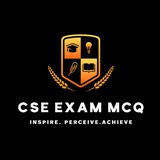With reference to 1960 Indus Water Treaty, consider the following statements :
1. The treaty sets out a mechanism for cooperation and information exchange between India and Pakistan regarding their use of river water
2. Washington based World Bank is a signatory to the treaty
3. Under the Indus Water Treaty (IWT), all the waters of Sutlej, Beas, and Ravi is allocated to India for unrestricted use
1. The treaty sets out a mechanism for cooperation and information exchange between India and Pakistan regarding their use of river water
2. Washington based World Bank is a signatory to the treaty
3. Under the Indus Water Treaty (IWT), all the waters of Sutlej, Beas, and Ravi is allocated to India for unrestricted use
Which of the statements given above are correct?
Anonymous Quiz
43%
1 , 2 and 3
26%
1 and 3 only
9%
2 and 3 only
22%
1 and 2 only
Consider the following countries :
1. Brazil
2. Mexico
3. India
4. China
5. South Africa
1. Brazil
2. Mexico
3. India
4. China
5. South Africa
❤2
Q.: The average height of the Kosi plain from mean sea level is
Anonymous Quiz
29%
300 m
49%
150 m
18%
30 m
4%
None of the above
Q.: Which of the following Indian states shares a boundary with Bangladesh and Myanmar?
Anonymous Quiz
10%
Assam
41%
Mizoram
35%
Tripura
14%
West Bengal
🔥2❤1
Q.: Which of the following effects is commonly associated with La Niña conditions?
Anonymous Quiz
9%
Increased global temperatures
51%
Heavy rainfall in the Eastern Pacific
21%
Drought in Southeast Asia
20%
Warming of ocean surface waters
👎1🥰1
Q.: Consider the following statements regarding the Collegium System:
1. The Collegium System allows the Prime Minister to directly appoint judges to the Supreme Court without any consultation.
2. The Chief Justice of India and a group of senior judges constitute the Collegium responsible for judicial appointments.
3. The Collegium System was introduced by the Constitution of India during its enactment in 1950.
4. The recommendations made by the Collegium for judicial appointments are mandatory and cannot be rejected by the President of India.
1. The Collegium System allows the Prime Minister to directly appoint judges to the Supreme Court without any consultation.
2. The Chief Justice of India and a group of senior judges constitute the Collegium responsible for judicial appointments.
3. The Collegium System was introduced by the Constitution of India during its enactment in 1950.
4. The recommendations made by the Collegium for judicial appointments are mandatory and cannot be rejected by the President of India.
❤4
Which of the above statements is/are correct?
Anonymous Quiz
35%
Only 2
16%
1 and 3
45%
2 and 4
3%
3 and 4
❤2
Q.: Consider the following statements regarding the 42nd Amendment to the Constitution of India:
1. The 42nd Amendment is known for restoring the original Constitution of India as enacted in 1950.
2. It amended the Preamble of the Constitution to include the words "Socialist" and "Secular."
3. The Amendment increased the term of the Lok Sabha from five to six years.
4. It established the procedure for the appointment of Governors in Indian states.
1. The 42nd Amendment is known for restoring the original Constitution of India as enacted in 1950.
2. It amended the Preamble of the Constitution to include the words "Socialist" and "Secular."
3. The Amendment increased the term of the Lok Sabha from five to six years.
4. It established the procedure for the appointment of Governors in Indian states.
👎2
Which of the above statements is/are incorrect?
Anonymous Quiz
17%
Only 3
27%
1, 2 and 4
34%
1, 3 and 4
22%
1 and 2
👎3❤1
Q.: From which of the following constitutions did India borrow the concept of Directive Principles of State Policy?
Anonymous Quiz
8%
American
11%
French
11%
Canadian
70%
Irish
Q.: Which of the following terms is often associated with the judicial activism seen in Public Interest Litigation (PIL)?
Anonymous Quiz
53%
Accountability
15%
Executive
18%
Legislation
14%
Referendum
Q.: Which of the following bodies is responsible for reviewing the administration of the 5th schedule in Indian states?
Anonymous Quiz
48%
Governor
38%
President
5%
Chief Minister
8%
Parliament
❤2
Q.: Which Article of the Indian Constitution mentions the Promotion of Educational and Economic Interests of Scheduled Castes, Scheduled Tribes, and other weaker sections?
Anonymous Quiz
18%
Article 41
52%
Article 46
16%
Article 27
14%
Article 30
❤1
Q.: Which of the following is NOT considered part of the Basic Structure of the Indian Constitution?
Anonymous Quiz
11%
Judicial Review
63%
Emergency Provisions
16%
Separation of Powers
9%
Fundamental Rights
Q.: Which of the following bodies is responsible for reviewing the administration of the 5th schedule in Indian states?
Anonymous Quiz
59%
Governor
29%
President
7%
Chief Minister
5%
Parliament
❤1
Q.: Consider the following statements about “Startup India Scheme”:
1. The Start-up India Scheme, launched in January 2016, aims to promote innovation and entrepreneurship across the country.
2. It provides tax exemptions for a period of seven years for eligible start-ups that fulfill certain criteria.
3. The scheme includes the establishment of a Start-up Fund to provide direct funding to start-ups, irrespective of their operational viability.
4. The initiative also emphasizes the simplification of regulatory processes to facilitate business operations for new enterprises.
1. The Start-up India Scheme, launched in January 2016, aims to promote innovation and entrepreneurship across the country.
2. It provides tax exemptions for a period of seven years for eligible start-ups that fulfill certain criteria.
3. The scheme includes the establishment of a Start-up Fund to provide direct funding to start-ups, irrespective of their operational viability.
4. The initiative also emphasizes the simplification of regulatory processes to facilitate business operations for new enterprises.
❤2
